Conservation Agriculture is a holistic approach characterized by minimal soil disturbance, diversified crop rotations and surface crop residue retention aimed not only at conserving soil and water but also biotic bases of sustainability. It is a resource saving concept that strives to achieve acceptable profits together with high and sustained production level while concurrently conserving the environment. CA is a scientific response to the question of sustainability that agriculture is facing today in the sense that it helps to reduce cost of production, saves time, increases yield through timelier planting and reduce greenhouse gas emissions.
Introduction
Conservation Agriculture Sustainable Intensification (CASI) is generalized as a system of sustainable food production from less inputs through more efficient use of resources and with minimal impact on environment. It also implies improving the capacities of people and their institutions to deliver and use inputs efficiently so as to avoid excessive wastage and harness large scale ecosystem services that benefits producers and consumers alike. This approach doesn’t attempt to have no impact on the environment but to limit any environmental footprint to a level below the natural recovery capacity. Above all, CASI is necessary to achieve and sustain increased yield in ways that don’t harm the resource base and the environment.
History
The concept of CA came up in USA in 1930’s when devastating dustbowl was produced by tillage in fallow lands. As a result of dust bowl, US Soil Conservation Act 1985 was passed and the Soil Conservation Service was created. Modern CA technology was elaborated by Edward Faulkner in the book, ”Ploughman Folly” ( Faulkner 1945)and was applied in Brazil in 1970 with collaboration of research scientists and leading farmers.
South America required 20 years for its adoption. At the same time, farm equipment and agronomic practices were improved and developed gradually. Only after 1990’s, it was extended exponentially to South America, Brazil, Argentina, and Paraguay. It was then the subject matter of study to FAO, World Bank, GIZ, CIRAD, and CGIAR. Similarly, this technology has also been spread to industrialized countries like Canada, USA, Australia, Spain, and Russia.
The cultivable land under CA has been rising year by year at the rate of 10Mha per year. In world, the total cultivable area under CA is 9 % as compared to conventional agriculture. It is practiced by the farmers from sea level to 3000 m, Arctic area to equatorial tropics, sandy loam to clay loam soils and farm sizes from 0.5 ha. to 1000 ha.
Conservation Agriculture, being considered as a suitable technique, was introduced in Nepal in around 1996/97 for controlling soil erosion and enhancing productivity. Under this, NARC (Nepal Agriculture Research Council) and DOA (Department of Agriculture) are working at national, regional and district levels through different programs. CSISA (Cereal Systems Initiative for South Asia) Nepal has been promoting CA based technologies for specific crops like Rice, Maize, Wheat, and Lentil in eastern and mid terai. Similarly, IFAD (International Fund for Agricultural Development) and CIMMYT are also involved in testing and promoting CA technologies in Maize based systems in western terai and adjoining hills of Nepal. The 4-year project named SRFSI is considered most pivotal for developing the CASI technologies in Nepal and disseminating the knowledge to the farmers. DSR (Direct Seeded Rice) and Zero Till in wheat has been initiated in terai districts of Nepal like Chitwan, Bara, Parsa, Nawalparasi, etc. Since the technologies are practiced mainly in research stations, small land holders haven’t adopted it yet.
Principles
Minimum soil disturbance is the basic principle of CA which aims at improving soil physical and chemical properties, reduce soil compaction, water loss and erosion and establish satisfactory crop stand. This can be achieved by minimum tillage, zero tillage and stubble mulch tillage practices.
- Minimum tillage is a group of field preparation methods which reduces the physical manipulation of soil. It is aimed at reduction of tillage to the minimum necessary that ensures a good seed bed, rapid germination, a satisfactory crop stand and favorable growing conditions.
- Zero tillage is the technique of conservational tillage where primary tillage is completely avoided and secondary tillage is restricted to the row zones where seeds are sown.
- Stubble mulch tillage is the technique where a mulch crop is grown during the fallow period and incorporated into the soil or the stubbles of previous crop are uprooted and spread over the soil surface.
- While implementing the practices for minimum soil disturbance, the use of herbicides and pesticides is mandatory in order to reduce the infestation of weed and chance of infections.
Crop residues are the left overs in the field after grains have been harvested. In the past, they were considered as waste but researches have shown that they have very high value in nutrient, erosion control, infiltration, carbon sequestration and many more. Crop residue should be left in the field instead of harvesting.
Crop residues are important source of nutrient for maintaining soil productivity. Crop residues differ in terms of nutrient content in them. It was found that leaves and husks contain more nutrient than stalk. To maintain soil organic matter at its best, it is estimated that 2 to 3 ton/acre of crop residue should be left in the field annually through conservation tillage or no till system.
Crop diversification refers to the addition of new crops or cropping systems to agricultural production on a particular farm taking into account the different returns from value-added crops with complementary marketing opportunities. It is intended to give a wider choice in the production of a variety of crops in a given area so as to expand production related activities on various crops and also to lessen risk. It is generally viewed as a shift from traditionally grown less remunerative crops to more remunerative crops. Often low volume high-value crops like spices also aid in crop diversification. Crop diversification and also the growing of large number of crops are practiced in rainfed lands to reduce the risk factor of crop failures due to drought or less rains. Crop substitution and shift can be done in the areas with distinct soil problems. For example, the growing of rice in high water table areas replacing oilseeds, pulses and cotton; promotion of soybean in place of sorghum in vertisols (medium and deep black soils) etc.
The aim of crop diversification is to increase crop portfolio so that farmers are not dependent on a single crop to generate their income. Diversification of agricultural production can increase natural biodiversity, strengthening the ability of the agro-ecosystem to respond to various stresses, reducing the risk of total crop failure and also providing producers with alternative means of generating income.
Components
A machine refers to anything that uses power and electricity to operate, simplify the complexity of work and reduces human efforts. Agricultural machineries are the equipment which are used in agricultural field to carry out agricultural operations efficiently, quickly, smoothly and accurately. The sustainability of conservation agriculture relies on the degree to which the resource conserving agricultural equipments are used. Some of the equipments used in CAs are Minimum tillage equipments, direct seeding equipments (Planting sticks, Hand jab planters, Seed cum drill) and cover crop and weed management tools (Hand weeder, Knife, roller, Zam, wipe herbicide applicator). Use of machineries helps to conserve the soil, retain soil moisture, improves efficiency of agricultural inputs, reduce production costs and many more.
Seed is the basic, vital and crucial input for crop production. Improved seed refers to a seed produced through a series of seed production channel that is suited for a particular domain, have a specific Package of practices, superior than local cultivars in many characters and offer farmer to harvest a bumper amount of crop through its genetics potential for bulk production. Improved seed is one of the ways to increase the productivity without adding appreciably to the extent of land. Improved seeds are free from diseases, have high vigor and germination capacity and have optimum moisture content. Good return per unit area, higher production, genetic potential, lesser pest, insect and disease problems, fast and uniform emergence, wider adaptability, highly input responsive are the properties that makes improved seed basic tool for sustainable agriculture. Various research findings have shown that there is about 20-25% increment in the yield through use of improved seeds only.
Crop diversification refers to the addition of new crops or cropping systems to agricultural production on a particular farm taking into account the different returns from value-added crops with complementary marketing opportunities.Crop diversification leads to increase in income on small farm holdings, withstands the price fluctuation, help in mitigating ill-effects of aberrant weather balance of food demand, improves fodder for livestock animals, helps in conservation of natural resources (soil, water, etc.), minimize environmental pollution, reduces dependence on off-farm inputs, decreases insect pests, diseases and weed problems.
Crop Rotation involves planting different crops in the same area at different times of the year or in different year. Crop rotation promotes differential uptake of nutrients due to different nature of crops and this can aid in conservation of soil nutrients. The introduction of legumes for crop rotation can aid to the addition of nitrogen to the field and enhance the condition of nutrients in the field ultimately reducing the requirement of fertilizers. The growing of same crop in the same field promotes the habitat for pests and crop rotation thus can break the life cycle of pests and diseases in the crop. This ultimately leads to the conservation of the nature.
Importance
Productivity increases are common in well managed CA systems. Yield increases of 12-20% were measured in wheat, barley, lentil and chickpea, when all principles of CA were employed along with early sowing in experiments over four years. A key step in achieving grain yield improvement is the successful establishment of the ZT crop. The average wheat yields of farmer who used ZT and early sowing were 160-495 kg/ha greater than farmers using conventional tillage and sowing times. Yield increases are also evident in both dry and favorable seasons, and in fields where supplemental irrigation is used. These yield increases can be attributed to increased rainfall infiltration (reduced run-off), moisture conservation over summer and during the growing season, enhanced water-use efficiency of the early sown crops, and improved soil structure and fertility. So CA helped avoid the effects of drought and enabled crops to produce useful yields even in the driest conditions.
The elimination of plowing costs, along with reductions in seed inputs decreases the cost of crop production. Even without any increase in production (which is sometimes the case), CA usually reduces costs and thereby increases profits. But when combined with the production increase discussed above, the net economic effect is significant. Of course other crops will also benefit from CA. Similarly, CA could have a major impact on the economic productivity and food security of many countries across the Middle East and North Africa, reducing their reliance on imports to feed their populations.
The adoption of CA can help improve the quality of soils, water systems, and air. Reduced soil erosion due to less exposure to both water runoff and wind, is a major benefit of the low soil disturbance and soil cover principles of CA. As less land is plowed and more soil is covered with residues, the severity of dust storms will decline. Improvements in soil fertility, especially soil structure and cycling of nutrients through the use of legumes, can reduce the need for fertilizer applications, and reductions in weeds, diseases and pests may decrease the reliance on pesticides. There has been much speculation about the ability of CA to increase soil organic matter, sequester carbon and possibly mitigate the effects of carbon dioxide emissions and greenhouse gas effects. ZT can reduce the use of fossil fuels and greenhouse gas emissions associated with agricultural production in some cases. After six years of CA experiments in Syria, the carbon sequestration rate measured was in the range of 0.27 to 0.30 Mg C/ha/year, and this rather modest increase was probably due to low to moderate crop productivity and a reasonable starting soil organic matter content of about 1.3 percent.
Cultivation Protocols
|
S. N. |
DAYS |
FIELD OPERATIONS |
|
1 |
6 days before transplanting |
Spraying of glyphosate@1kg a.i./ha |
|
2 |
1-2 days before transplanting |
Dry tillage using single pass wih power tiller /rotavator with 150 kg N-P-K(10-26-26)/ha followed by irrigation and laddering |
|
3 |
On the day of transplanting |
Transplanting with Rice Transplanter* using 18-20 days old seedlings from mat nursery |
|
4 |
1-2 days after transplanting |
Spraying of Pendimethalin @1kg ai/ha / Pretilachor @0.5 kg ai/ha |
|
5 |
20-22 days after transplanting |
Bispyrabic-Na @25g ai/ha +Pyrazosulfuron @20g ai/ha OR Fenaxoprop@ 90ml ai/ha +Ethoxysulfuron @18g ai/ha OR Weeding with paddy weeder |
|
6 |
25-26 days after transplanting |
First Top Dressing (Urea 90 kg/ha) |
|
7 |
30 days after transplanting |
Spraying of Chellated Zn (1 g/liter water) |
|
8 |
35-40 days after transplanting |
Bispyrabic-Na @25g ai/ha +Pyrazosulfuron @20g ai/ha OR Fenaxoprop@ 90ml ai/ha +Ethoxysulfuron @18g ai/ha OR Weeding with paddy weeder |
|
9 |
45 days after transplanting |
Second Top dressing ( Urea 60 kg + MOP 37.5 kg/ha) |
|
10 |
50-55 days after transplanting |
Spraying of Chellated Zn (1 g/liter water) |
| SL. No. | DAYS | ACTIVITIES |
|---|---|---|
| 1 | 6 days before seeding | Spraying of Glyphosate @1 kg a.i./ha (100ml/tank) |
| 2 | On the day of seeding | Seeding with Multi crop Planter (seed rate 20kg/ha) NB:Planter should be calibrated at 200-240 seeds over 50m from a single tyne(~83000plants/ha) |
| 3 | On the day of seeding | Fertilization appication through Muti crop planter@ N-P-K (10-26-26)@256 kg /ha; seeds should be treated with Carbendazim @5g/kg of seeds; Fipronil Granules(@20kg/ha) should be mixed in the fertilization box |
| 4 | 1-2 days after seeding | Spraying of Atrazine@ 1kg a.i./ha OR Pendimethalin @ 1kg a.i./ha OR If Tembotrione(Laudis)is planned as post emergence application, this operation may be skipped |
| 5 | 28-30 days after seeding | Spraying of Boron (20%) @0.2% |
| 6 | 30-35 days after seeding | Irrigation + First Top Dressing(Urea150kg/ha).The Urea must be applied before irrigation by band placement parallel to maize line rather than random broadcasting |
| 7 | 35-40 days after seeding | Spraying of Tembotrione @120g a.i./ha OR Atrazine @ 0.5kg a.i./ha + Tembotrione @120g a.i./ha |
| 8 | 50-55 days after seeding | Spraying of Boron (20%) @0.2% + Chellated Zn (1g/liter water) |
| 9 | 60-65 days after seeding | Irrigation + Second Top Dressing(Urea @150kg + MOP @ 37.5 kg/ha). The Urea and MOP must be applied before irrigation by band placement parallel to maize line rather than random broadcasting |
| 10 | 70-75 days after seeding | Spraying of Boron (20%) @0.2% + Chellated Zn(1g/liter water) |
| 11 | 75-80 days after seeding | Irrigation* NB:(*)Subsequent irrigation(if needed) based on soil moisture |
- Use Flat Fan Nozzle while spraying herbicides
- For mixing two separate herbicides, stock solution has to be prepared before mixing the herbicides in tan
- The dates in the protocols can be modified based on location
- Previous crop residues should be retained at least @ 5t/ha
- For maize , sometimes soil are to be treated with Chlorpyriphos to protect the seeds against borer
| SL. No. | DAYS | ACTIVITIES |
|---|---|---|
| 1 | 6 days before seeding | Spraying of glyphosate @1kg a.i./ha |
| 2 | On the day of seeding | Sowing with Zero Till Drill(seed rate 120kg/ha) N.B.: 120-130g seeds over 50m from a single tyne as calibration |
| 3 | On the day of seeding | Fertilizer application with zero till drill@N-P-K(10-26-26)@187.5/ha |
| 4 | 1-2 days after seeding |
Spraying of Metribuzin 70% @250g/ha OR Pendimethalin @ 1kg a.i./ha |
| 5 | 15-18 days after seeding | Irrigation+First top dressing(Urea 135kg/ha) |
| 6 | 22-25 days after seeding | Spraying with Clonidofop @60kg a.i./ha(if grass pressure is high) OR Clodinafop propargyl 9% + Metribuzin 20% @600g/ha |
| 7 | 32-35 days after seeding | Spraying of Carfentrazone ethyl @ 20g a.i./ha+Metsulphuron methyl @4g a.i./ha |
| 8 | 35-40 days after seeding | Spraying of Boron (20%) @0.2% |
| 9 | 40-45 days after seeding | Irrigation + Second Top dressing (Urea 90 kg + MOP 37.5kg/ha and it should be done just before irrigation |
| 10 | 55-60 days after seeding | Spraying of Boron (20%) @0.2% |
| 11 | 75-80 days after seeding | Supplementary irrigation* N.B.: (*) after flowering is complete, if possible depending on the moisture condition |
- Use Flat Fan Nozzle while spraying herbicides
- For mixing two separate herbicides, stock solution has to be prepared before mixing the herbicides in tank
- The dates in the protocols can be modified based on location
- Previous crop residues should be retained at least @ 5t/ha
- For wheat, sometimes soils are to be treated with Chlorpyriphos to protect the seedling against borer
| SL. No. | DAYS | ACTIVITIES |
|---|---|---|
| 1 | 6 days before seeding | Spraying of Glyphosate @ 1kg a.i./ha |
| 2 | On the day of seeding |
Sowing with Zero Till Drill/ Multi crop planter (Seed rate 25-28 kg/ha) N.B.: 25-30 gram seeds over 50m from a single tyne calibration OR Surface seeding is also possible if moisture permits |
| 3 | On the day of seeding | Fertilizer application through Zero till drill / Multi crop planter@ N-P-K (10-26-26) @ 187.5/ha |
| 4 | On the day of seeding | Seed treatment with Rhizobium + Trichoderma viride + PSB(5g/kg of seeds) |
| 5 | On the day of seeding | Cutting rice stubbles (mulching); Light irrigation if needed |
| 6 | 1-2 days after seeding | Spraying of Pendimethalin 1kg a.i./ha + Imizathapyr 10% @750g/ha |
| 7 | 20 days after seeding | Spraying of Boron (20%) @ 0.2% |
| 8 | 22-25 days after seeding |
Spraying of Liquid Fertilizer (19-19-19 @ 5g/litre or DAP 2%)followed by a light irrigation |
| 9 | 35-40 days after seeding | Spraying of Boron (20%) @ 0.2% |
| 10 | 70-75 days after seeding | Irrigation* N.B.: (*) Subsequent irrigation (if needed) based on soil moisture |
- Use Flat Fan Nozzle while spraying herbicides
- For mixing two separate herbicides, stock solution has to be prepared before mixing the herbicides in tank
- The dates in the protocols can be modified based on location
- Previous crop residues should be retained at least @5t/ha
- For surface seeding of mustard/lentil, soil moisture are to be assured; otherwise, it will be followed by light irrigation
- Mulching with previous rice straw in mustard or lentil helps to conserve moisture and at the same time reduces the weed pressure
- If Stemphyllum blight appears at the initial stage Metalaxyl + Mancozeb @ 2% may be used
- If February when the temperature starts to rise, Spraying of Trifloxastrabin + Tebuconazole @300kg/ha is to be sprayed
| SL. No. | DAYS | ACTIVITIES |
|---|---|---|
| 1 | 6 days before seeding | Spraying of Glyophosate @ 1 kg a.i./ha / Pre- plant application of Pendimethalin(45ml/tank) 3 days before sowing |
| 2 | On the day of seeding |
Sowing with Zero Till Drill ( Seed rate 7.5kg/ha with dry dry vermicompost @60kg/ha OR Surface seeding if possible depending on soil moisture |
| 3 | On the day of seeding | Fertilizer application through Zero till drill @ N-P-K (10-26-26) @150 kg / ha |
| 4 | On the day of seeding | Cutting rice stubbles (mulching); Light irrigation if needed |
| 5 | 1-2 days after seeding | Spraying of Pendimethalin @ 1kg a.i./ha |
| 6 | 15-20 days after seeding | Irrigation + First top dressing (Urea 90kg/ha) |
| 7 | 20-25 days after seeding | Spraying of Boron (20%) @ 0.2% |
| 8 | 35-40 days after seeding | Irrigation + Second top dressing (Urea 60kg/ha) |
| 9 | 35-40 days after seeding | Spraying of Boron (20%) @ 0.2% |
| 10 | 70-75 days after seeding | Irrigation* N.B.:(*) Subseuent irrigation (if needed) based on soil moisture |
- Use Flat Fan Nozzle while spraying herbicides
- For mixing two separate herbicides,stock solution has to be prepared before mixing the herbicides in tank
- The dates in the protocols can be modified based on location
- Previous crop residues should be retained at least @ 5t/ha
- For surface seeding of mustard/lentil, soil moisture are to be assured; otherwise, it Will be followed by light irrigation
- Mulching with previous rice straw in mustard or lentil helps to conserve moisture and at the same time reduces the weed pressure
- If white rust appears at the initial stage Metalaxyl + Mancozeb @ 2% may be used.
Machineries Used
Zero tillage or no-tillage farming is a way of growing crops or Pasteur from year to year without disturbing the soil through tillage. Zero tillage machine is machine which is used for zero tillage or no-tillage farming. It has deep ploughing drill, fitted with container through which seeds are sown in field. Agricultural land where soil erosion through wind and rain is severe should practice zero tillage technique.
About 30% of the crop residues are left in field to be incorporated in soil. Researches from India has shown that, there is chances of about 16 percent yield increase.
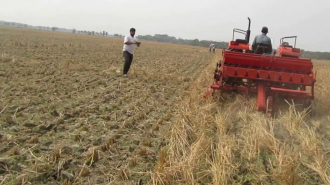
The happy seeder offers the means of drilling wheat into rice stubble without burning, eliminating air pollution and loss of nutrient and organic carbon due to burning, at the same time as maintaining or increasing yield. It can be operated with hand tractor or power tiller or tractor. Crops in which used: Mainly used for wheat after the rice harvesting, to reduce time and manage rice stubble.
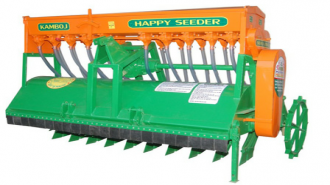
Seed cum fertilizer drill is used for simultaneous activities of seeding and fertilization process in single operation. It drills seeds and fertilizer together but delivers them separately in a single drive. The seeds and fertilizer are drilled at different depth, thus insures improved germination. There is separate container for seeds and fertilizer. Use of seed cum fertilizer drill helps to use fertilizer in plant near area and also in the zone where fertilizer loss is low and uptake by plant is high. This ensures efficient use of limited fertilizer. It is operated through tractor. This machine could be used for variety of field crops such as: Maize, Wheat, Barley, Pulses, Peas, Black grams etc.
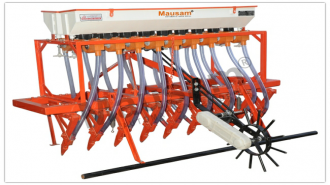
As suggested by name, Rice transplanter is specialized transplanter used for the transplanting of rice with both machines operating i.e. riding type and hand operating i.e. walking type. This machine is suitable where the land is more or less leveled. Machine transplanting using rice transplanters requires considerably less time and labor than manual transplanting. It increases the approximate area that a person can plant from 700 to 10,000 square metres per day.
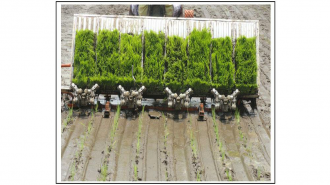
Removal of unwanted plants is utmost for optimum production of agricultural crop. But conventional practices of weeding took more time and human resources, thus resulting in low profit and reduced production. The machine could be used instead of manual weeding which reduces the weeding time and increases overall efficiency of weeding. Different mechanical weeder are available nowadays which will perform efficiently with limited human resources and within limited time. Mechanical weeder can be used in every crop i.e. cereals, vegetables, fruits, flowers etc. which is cultivated in definite geometric pattern, rather than broadcasting. Every crop has certain critical weeding period, to ensure weed free field during such duration mechanical weeder is very useful.

Reaper is any machine that help in harvesting of cereal grains when they are fully ripe. Reaper simply cut the crop and dropped it unbound on field. Conventional harvesting technique of cereal crop is very laborious work, this consumes more human resource and time for the work to be done.
Instead, increased efficiency in both i.e. in terms of time and human resources for harvesting of cereal crop can be achieved by use of Reaper. This will increase profitability of farm.
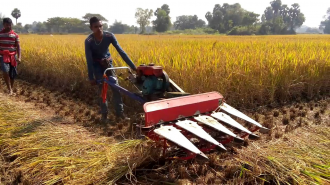
It is only different from Reaper that it cut and bind the crop before get dropped into field. Extra manual work is required when harvested by Reaper to bind the crop for threshing purpose. But Reaper cum binder automatic binds the crop during harvesting, thus makes easy to collect and extra human resource is not required for binding. Thus, reduces the input cost for production and increases profitability.
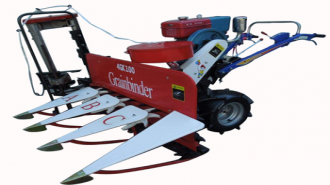
A combine harvester, or simply a combine, is a machine designed to harvest variety of grain crops efficiently. It combines the tasks of harvesting, threshing, and cleaning grain crops- into a single process. The objective is the harvest of the crop such as; rice, corn (maize), sorghum, soybeans, flax (linseed), oats, wheat, rye …etc.
The waste straw left behind on the field is the remaining dried stems and leaves of the crop with limited nutrients which is either chopped and spread on the field or baled for feed and bedding for livestock.
This is heavy machineries, thus can be only used efficiently in plain terai region. This machine is expensive for a single farmer.

Technologies Used
Introduction
DSR is a resource conservation technology which involves sowing of seeds directly into the main field using seed drill rather than transplanting seedlings.
Field Preparation
DSR can be done on the same field as in the case of puddled transplanted rice but good leveling must be done for conserving the moisture, better crop emergence and better yield. The seeds can either be sown under conservation tillage or zero till method depending on site-specific factors.
Sowing
One can sow the seeds by two methods: 1) In moist soil condition and 2) In dry soil condition. It depends on the weather condition and the irrigation facility available. Since the seed quality greatly influences the germination rate, it is recommended to use the certified seeds at a seed rate 20-30 kg/ha having germination percentage >95%. The seeding depth is critical and the seeds must be sown at 1-2 cm and not deeper than 3 cm.
Varieties
Short duration varieties like Radha 4, Hardinath 2, Sukkha dhan 1, Tara,etc. are suitable only for the upland condition. Medium and Long duration varieties like Ramdhan, Sabitri, Loktantra, Mithila, Sukkha 4, etc. can also be used for the lowland condition.
Seed Treatment
Seed treatment such as priming i.e. soaking the seeds for 10-12 hours in a gunny bag, accelerates the crop emergence. The seed is then air dried and incubated and it must be sown into moist soil. Sowing into dry soil may adversely affect the emergence of pre-germinated seeds. Also seed treatment with fungicides can be done to manage the diseases such as rice blast, brown spot, false smut, etc.
Fertilizer Application
All fertilizers except urea should be applied at sowing. N dose varies depending on variety from 80-120kg/ha and applied in at least 3 minimum split doses. The requirement for other fertilizers is P₂O5 at 60 kg/ha, K₂O at 60 kg/ha and ZnSO4 at 25 kg/ha. DAP should be used with seed drill while sowing.
Weed Management
Since the weed infestation is high in case of DSR, it is necessary to manage the weeds either by preparing stale seedbed, or by manual hand/tool weeding or by use of chemical weedicides.
Irrigation
Irrigation is critical during first three weeks. It is required during tillering to flowering stage. There should be no water stress during Panicle Initiation and Grain filling Stage. It is crucial to have a better drainage facility for DSR.
Nursery Management
It is very necessary to manage the nursery for the better production of the crop. For the nursery, the best performing and most popular variety must be selected. Select the area near to irrigation facility, drainage facility and free from shade.
Seed Bed Preparation
A nursery area of 300-400 m2 is enough to produce seedlings for transplanting 1 acre of land. To prepare seed bed one must plough the field properly after the harvest of Rabi crop. Then add 2 quintals FYM/Compost per 300-400 m2 nursery fields at least 25-30 days prior to sowing and puddle the field using paddy puddler. Make 1-2 raised bed/s of 15 cm height and a length of about 1m with 30 cm drainage channel between the beds.
Seed Quality
Certified seeds of high yielding varieties or hybrids should be purchased from a reliable source. The seeds must be clean, pure and healthy if one is using own seeds.
Seed Treatment
Prior to sowing, soak the seeds in water inside bucket and then discard the floating seeds In case of own seeds, soak 1.5-2 kg seeds in 1kg salt per 10 liters of water. Use sprouted seeds for sowing. For this the seeds are soaked into treated water i.e. Bavistin 2g/kg seed or Saaf 3g/kg of seed and then incubated in gunny bags in a well ventilated place. The sprout length should not be more than 7-8 mm.
Seed Rate and Sowing
Seed rate of 10-16 kg for HYV and 5-6 kg for hybrids is optimum. Broadcast the sprouted seeds uniformly for better anchorage into the raised beds.
Seedling age for transplanting
For long duration varieties, use 30-35 days old seedlings, for medium duration varieties use 25-30 days old seedlings and for short duration varieties using of 20-25 days old seedlings. When conditions are favorable, use younger seedlings and use older seedlings to cope with submergence and salt stress.
Fertilizer application
Apply 4 kg DAP, 2.4 kg MOP and 1 kg Zinc Sulphate as basal dose. Then apply 2.8 kg Urea after 13-15 days of sowing. If Iron deficiency is observed, apply 0.5% Ferrous sulphate.
Weeding
Apply soft (Pretilachlor 30 EC+ Safener) 60 g in the nursery area by mixing with 5-6 kg of sand at 1-3 days after sowing in standing water.
Irrigation
To save the young seedlings from the intense sun, avoid water stagnation during the day. Thus, apply irrigation particularly during evening hours.
Diseases and their Management
1) RICE BLAST:

It is the major disease of rice throughout the world and is caused by a fungal pathogen Pyricularia oryzae. The symptoms appear on the above ground parts like leaf, leaf sheath, panicle etc. First eye shaped small spot is developed in the leaves which has ash coloured centre, brownish in margin and get yellowish colour in outer parts of margin i.e. yellowish halo. If the infection takes place in neck region, then it becomes weak and panicles are held down known as neck blast.
MANAGEMENT:
Use fungicides like Hinosan 50 EC 1.5 ml, Bavistin 50 WP 3 gm, or Dithane M45 3 gm per litre of water.
Seed treatment with Bavistin at the rate of 2.5 gm per kg of seed.
2) BROWN SPOT:
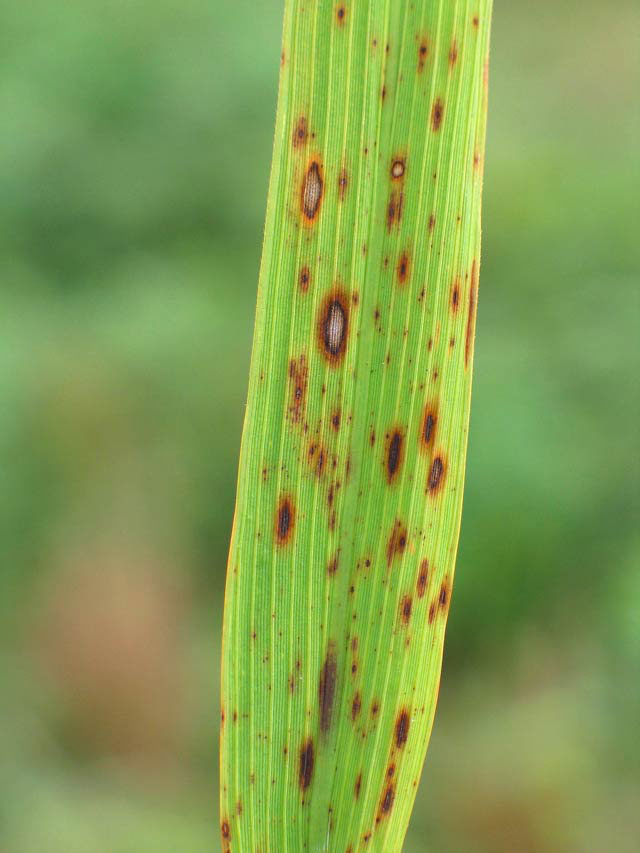
It is caused by fungus Helminthosporium oryzae .
MANAGEMENT:
Nitrogen should not be applied more than the recommended dose
Seed treatment with hot water or Dithane M-45 or Bavistin at the rate of 3gm per kg
Spary fungicides like Dithane M-45 or Bavistin at the rate of 3gm per litre
Biocontrol agents like Trichoderma herzianum, T viridae can be used
3) BACTERIAL LEAF BLIGHT:
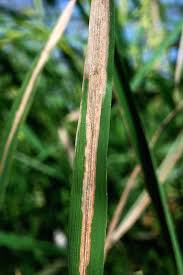
This disease is caused by bacteria Xanthomonas campestris . First the edges of the leaves develop wet specks and they gradually increase in size and become yellow and light brown in colour.
MANAGEMENT: Controlled irrigation in diseased field and raise seedlings in dry field rather than muddy fields
Use disease free seeds and seedlings
4) FALSE SMUT:
It is caused by Fungus Ustilaginoidea virens
MANAGEMENT:
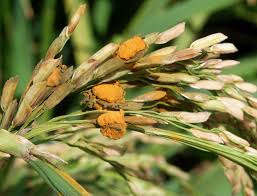
Seed treatment with Mercuric Chloride (HgCl2) to eliminate seed borne inoculum.
Rouging of affected panicles and use of balanced fertilizers and follow crop rotation
DOWNY MILDEW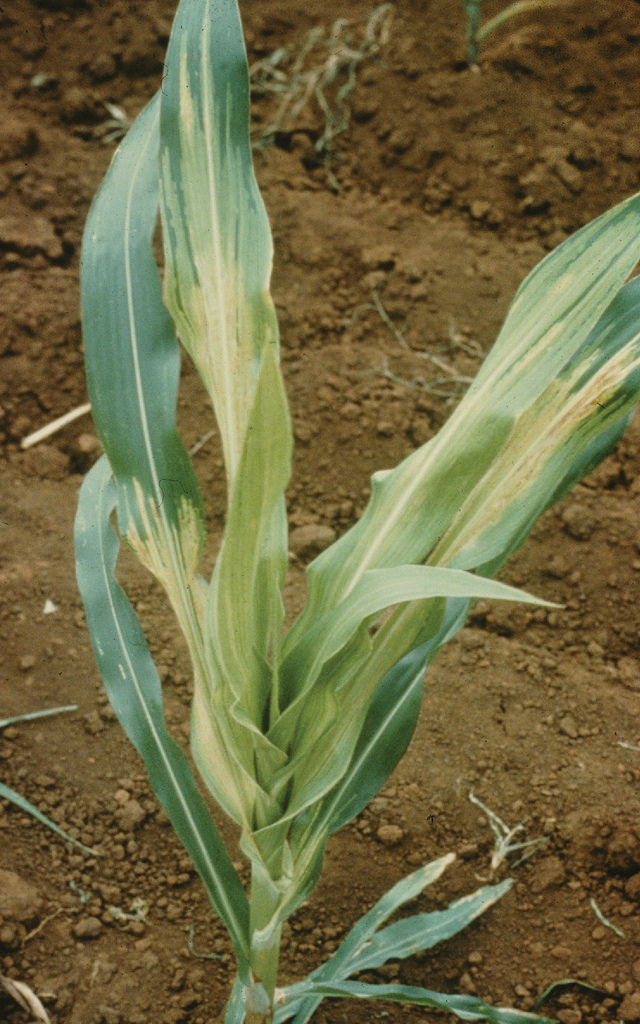
It is most common diseases of maize. In Nepal 2 types are found brown stripe downy mildew and philipino downy mildew which are caused by Scleropthora rassyi var. zeae and Peronosclerospora philipinensis respectively. In brown stripe type, symptoms appear on leaf as yellowish lesion in between veins which later on change into brown color also in morning downy fungal growth appears around lesion. In philipino type, there is crazy top symptoms i.e. dwarf plant with many leaves originating from limited region also leaves become small sized with chlorotic sometimes whitish appearance.
MANAGEMENT
- Seed treatment with mercurial or systematic fungicide Bavistin@ 2gm/kg seed. Spraying can also be done but it is not practical in farmers level.
- Use of resistant variety Rampur composite, Indian variety Ganga safeda is also resistant.
BLIGHT
Southern Leaf Blight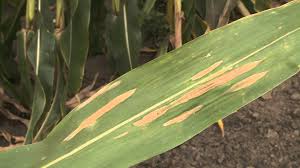
This is caused by two pathogens namely Drechslera maydis, Bipolaris maydis. Generally, it appears during summer season. Smaller boat shaped lesion developed in between veins which are initially chlorotic later change into brownish and finally becomes straw colored. The lesions never becomes blackish color.
Northern Leaf Blight
This is caused by multiple pathogens namely Helminthosporium turcicum, Drechslera turcicum, Bipolaris turcicum. It appears in winter season. Larger boat shaped lesion developed across the vein which are initially tan later change into brownish and finally becomes blackish.
Cercospora Leaf Blight
This is caused by Cercospora zeae-maydis and it is prevalent in hilly regions. It begins from lower leaves and 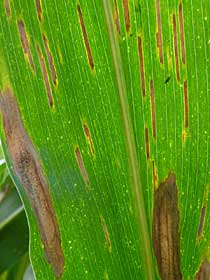 moves upward. Symptoms can be seen as rectangular tan spot in between veins which later changes into brown and finally becomes straw color. In severe case, whole plant may be killed.
moves upward. Symptoms can be seen as rectangular tan spot in between veins which later changes into brown and finally becomes straw color. In severe case, whole plant may be killed.
MANAGEMENT
- See treatment with fungicide like Captan, Thiodan.
- Foliar spray with Iprodine@ 0.1% (2-3 sprays at 15 days interval)
- Resistant variety like Rampur composite, Ganga Safeda can be used
- Removal of collateral host
STALK ROT
This is fungal and bacterial disease. The causative agent are fungus like Pythium debarianum, Fusarium moniliforme, Cephalosporium maydis, Diplodia maydis and bacteria like Erwinia carotovora, 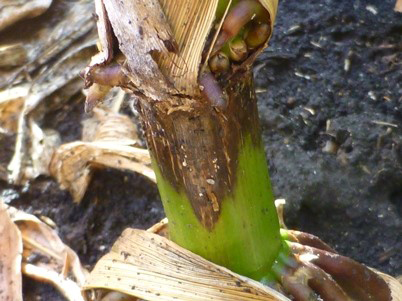 pseudomonas spp. In fungal rot, 1st and 2nd internode near the ground get attacked. Symptoms may appear as shrinking of attacked internodes, discoloration of pith (yellowish, reddish or brownish) and if we cut we can find dirty white fungal mycelial growth. In bacterial attack, nodes get discolored, bacterial ooze comes out from node with foul smell. In both of the cases plant get topple down even under light air blow.
pseudomonas spp. In fungal rot, 1st and 2nd internode near the ground get attacked. Symptoms may appear as shrinking of attacked internodes, discoloration of pith (yellowish, reddish or brownish) and if we cut we can find dirty white fungal mycelial growth. In bacterial attack, nodes get discolored, bacterial ooze comes out from node with foul smell. In both of the cases plant get topple down even under light air blow.
MANAGEMENT
- Soil treatment or soil solarization
- Use of bio control agent fungus like Trichodema harzianum, Trichoderma viride, Gliocladium virens and bacteria like Pseudomonas fluorescence.
- Development and use of resistant variety
RUST:
It is considered to be the oldest known disease. It is the potential cause of economic loss in all wheat growing areas. It is of three types: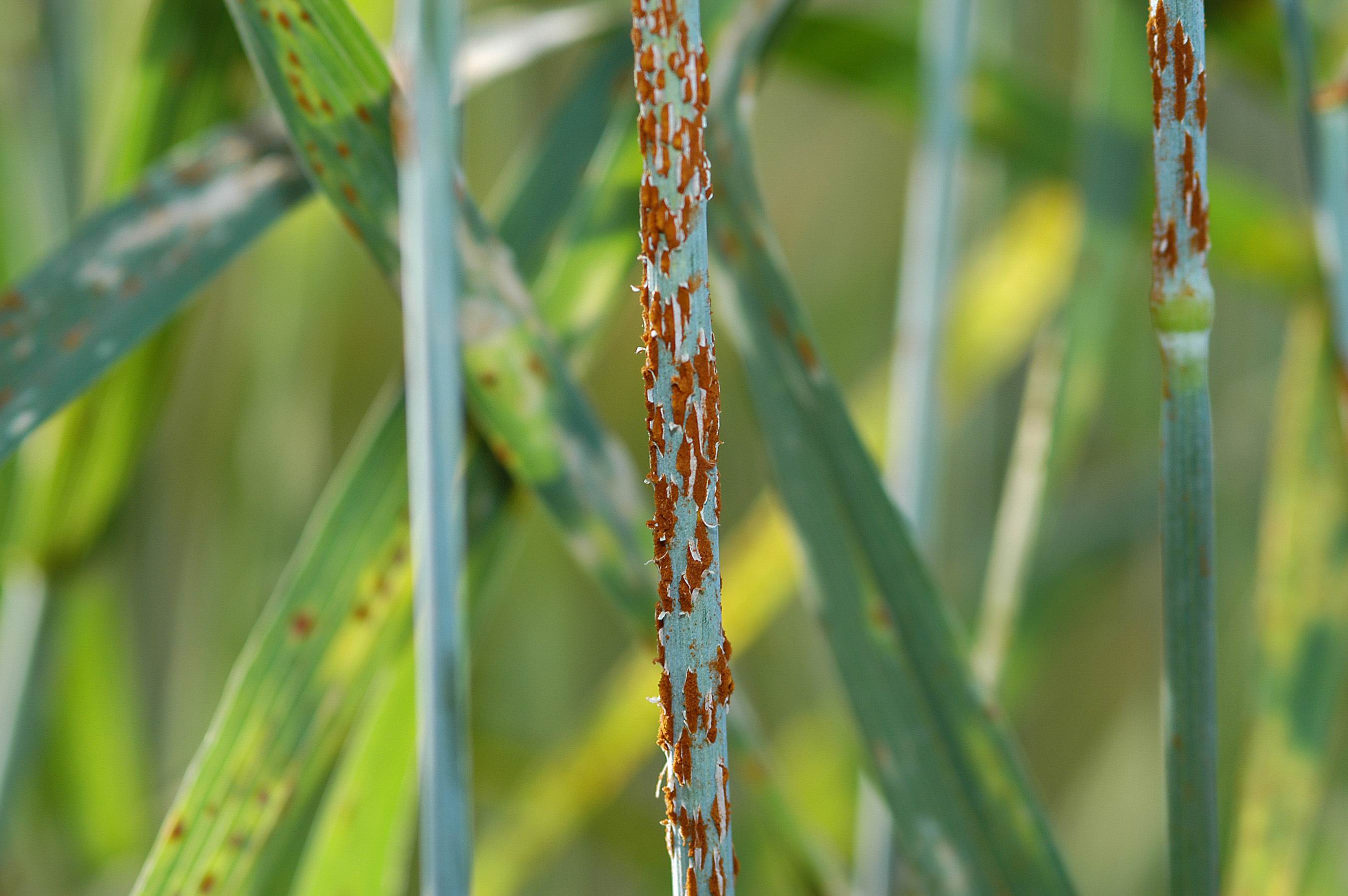
i)Black Stem Rust
Causative agent of this disease is Puccinia graminis tritici.This problem is high in the hills and mountains where local varities are cultivated. Due to the use of improved varities in Terai, this disease is not seen. Pustules are found on stem elongated and long brownish to black coloured. It may appear on leaves under severe condition.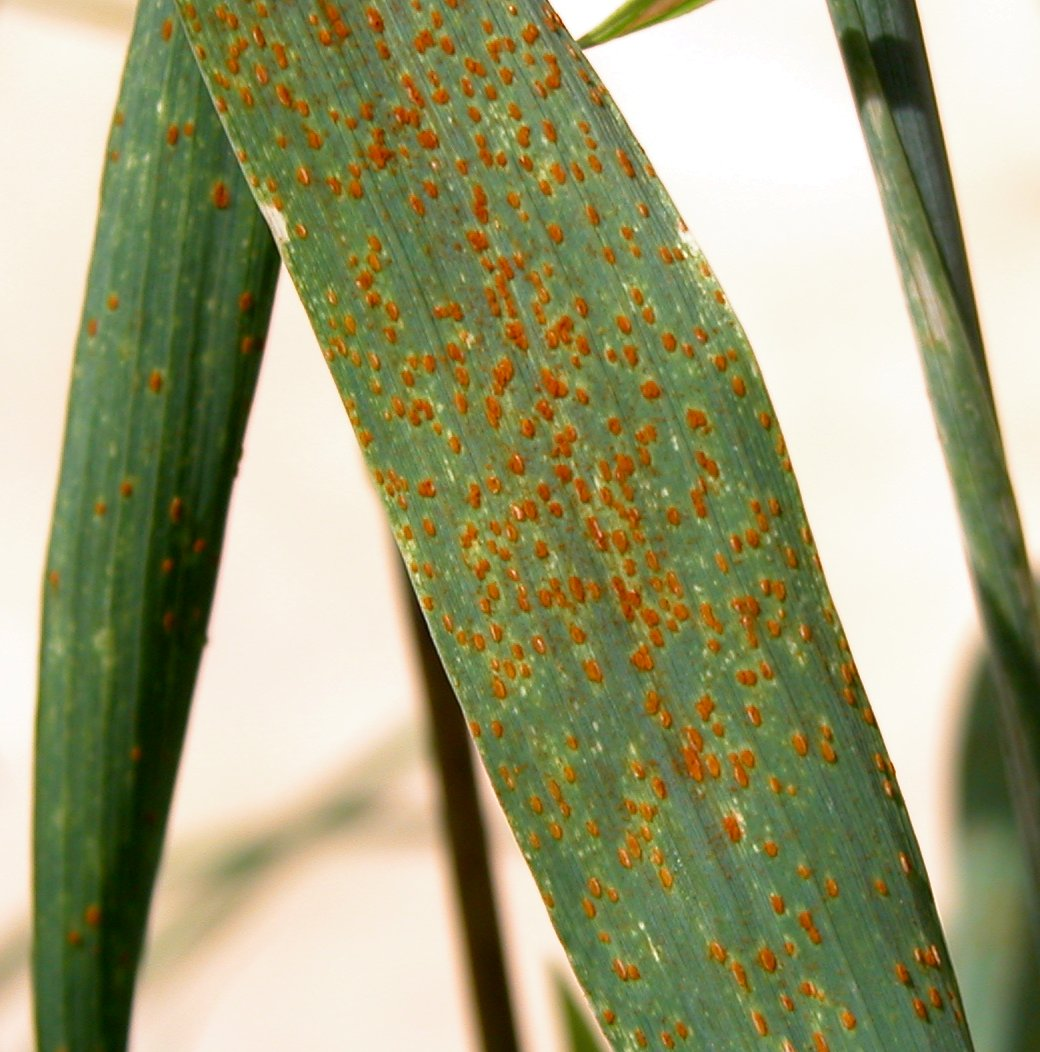
ii) Brown Leaf Rust
This disease is caused by fungus Puccinia recondite. Pustules are brown in colour and scattered all over the leaves. Pustules are spherical rarely seen on leaves.
iii)Yellow Striped Rust
Causative agent of this disease is Puccinia striiformis. Pustules are yellow in color confined along in between veins. 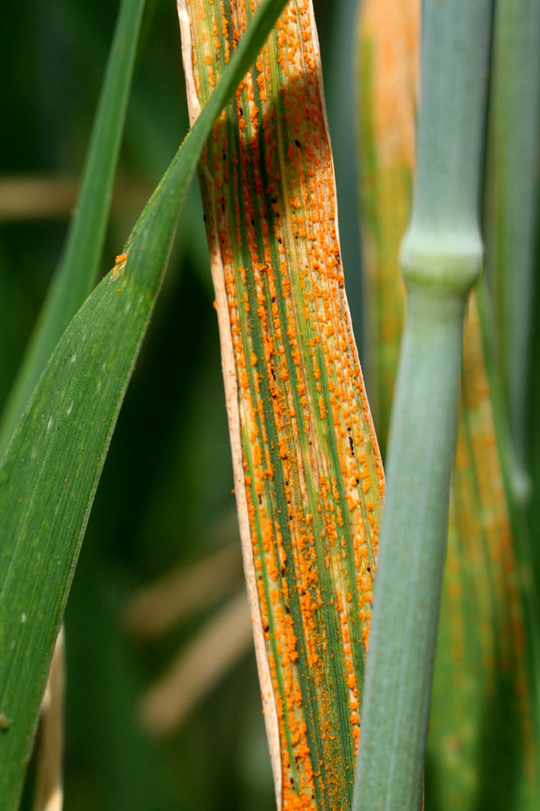 Pustules are elongated appear in linear fashion. It may also appear on leaf sheath in severe codition.
Pustules are elongated appear in linear fashion. It may also appear on leaf sheath in severe codition.
MANAGEMENT:
- Use resistant varieties like WK1204, Pasang Lhamu
- Use fungicides like Dithane M45 75% WP at the rate of 1.5-2 kg in 750 litres of water per hectare
- Short duration varieties of wheat should be recommended
- Cultivating susceptible varieties of wheat in high hills and resistant varieties in mid hills helps in controlling disease in main fields of Terai
LOOSE SMUT:
This is seen particularly in those areas where local varieties are cultivated. So this is serious in hilly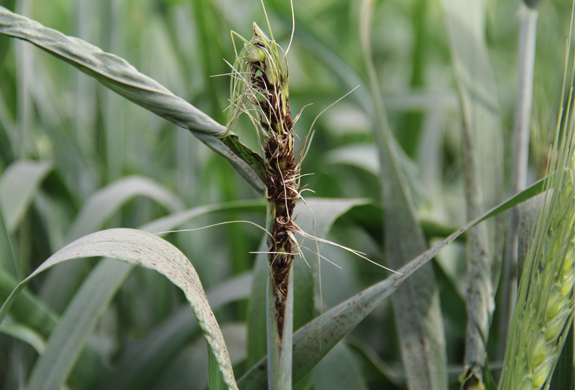 areas. Causative agent of this disease is Ustilago tritici .The infected plants are slightly taller than healthy plants and develop chlorotic leaves. All the spikelets of affected pants are transformed into black powdery mass of spores. There is no grain formation. Before emergence, the smutted spikelets are covered by a thin membrane which is silvery but it breaks while emerging out the earheads. These are loosely attached and can be blown up easily.
areas. Causative agent of this disease is Ustilago tritici .The infected plants are slightly taller than healthy plants and develop chlorotic leaves. All the spikelets of affected pants are transformed into black powdery mass of spores. There is no grain formation. Before emergence, the smutted spikelets are covered by a thin membrane which is silvery but it breaks while emerging out the earheads. These are loosely attached and can be blown up easily.
MANAGEMENT:
- Seed treatment with systemic fungicides like vitavax at the rate of 2gm per kg is effective
- Solar Heat Treatment: Seeds are soaked in cold water for 4-6 hrs, dormant mycelium becomes active and seeds are spread on cemented floor on direct sunlight for 4-6 hrs
- Hot water treatment at 550C for 10-15 mins.
- Development and use of resistant varieties
LEAF BLOTCH OR TANSPOT: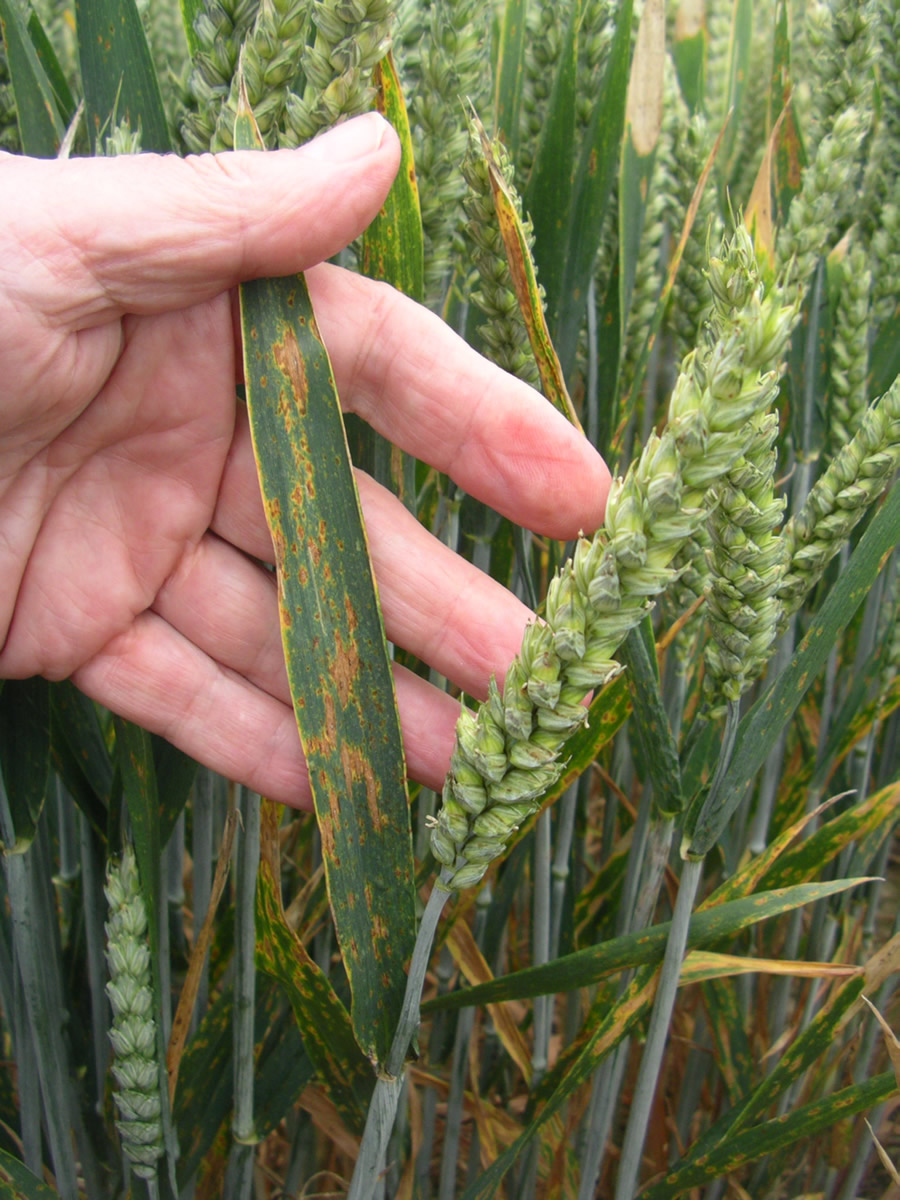
It is very common disease found throughout the Terai, Inner Terai, as well as in Hills. There is involvement of 2-3 pathogens in this disease namely Pyrenophora tritici-repentis, Bipolaris sorokiniana, Alternaria triticina. Spots appear as tan brown flecks which expand into the lens shaped and have yellowish halo around the spots. These tan blotches expand upto few mm long often with chlorotic or yellow borders. Such leisons may coalesce and become more dark brown in color.
MANAGEMENT:
- Development and use of resistant varieties: Chinese variety ‘Chiria’ is used for crossing to transfer resistant gene to other variety
- Chemicals like Tilt, Horizon can be used to spray. Just 2 spray can control the disease upto 95%.
- Early planting can escape severity of infection and Use of short duration varieties
STEMPHYLIUM BLIGHT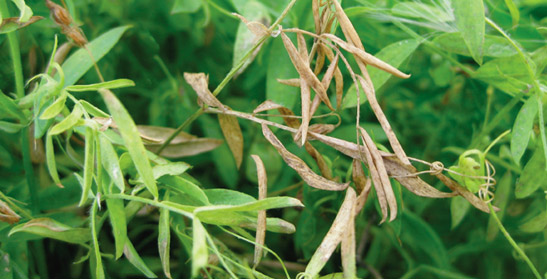
This is very severe in our country since 2-3 yrs. This is caused by Stemphylium botryosum f. sp. lentis. Initially disease may appear as a small back dots on young leaf but it spreads very fast covering all the leaves and flower also on steam and pods black lesions are found. When disease appear in epidemic form, the whole plant get killed.
MANAGEMENT
- Some lentil variety shows horizontal resistance so bring such variety under cultivation practice
- Fungicide like Iprodine and Dithane M45 can be used
- Low plant population and good drainage reduce the severity
Insect Pests and their Management
1. Brown plant hopper - Nilaparavata lugens
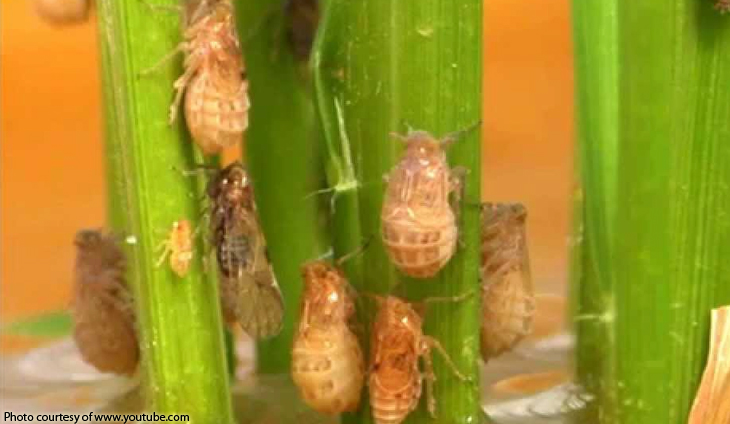
Both nymph and adult feed on paddy by sucking cell sap. The nymphs are brownish in color and have grayish blue eyes. They lay eggs in mass by lacerating parenchymatal tissues. The eggs are somewhat cylindrical having two distinct spots.
Damage: Suck the cell sap from the leaves and the leaves turns yellow. A heavy infestation produces symptoms of ‘hopper burn’ i.e leaves become dry and brown after insect feeding and the infected plant often lodges in patches. Even tillering is adversely affected. High humidity, optimum temperature, high nitrogen application and no wind favors growth of BPH.
Management
- Maintain proper spacing
- Grow resistant varieties IR26, IR36, IR56, IR64, and IR72
- Alternate drying and wetting of the field and draining of the standing water.
- Spray monocrtophos 35 EC @ 2ml/l (78 ml/ropani) at nursery stage.
- Application of granular phorate 10G@ 0.5 kg/ropani or carbofuran 3G@ 1.2kg/ropani insecticides in presence of thin film of water.
- Spray imidacloprid 200 SL @ 0.5ml (15 ml/ropani) or thiomethaxm 25WG @ 0.5g (15kg/ropani) or phaslone 35 EC @ 2ml/l (100ml/ ropani) water or quinolphos 5G @ 1.5kg/ropani.
2. Yellow rice stem borer - Scirpophaga incertulas
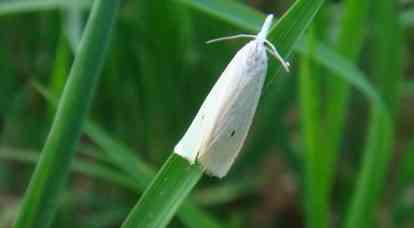
They are dirty white or greenish yellow having brown head and pronotum. Female moth is bigger than the male and has a centrally situated black spot on each of the forewing also female has prominent tuft or brownish yellow silken hair at the tip of their abdomen. They lay eggs on the underside of the leaves. The eggs are covered with yellowish brown hair of the female tuft.
Damage: causes death of the central leaf whorl at the vegetative stage known as dead heart and at reproductive stage causes ear devoid of grain known as white head.
Management
- Larva may be killed by flooding of the field in rainy season.
- Before the transplantation clip the tips of the seedlings
- Recommended insecticides and doses for spray (Twice at 7-10 days interval)
- Monocrotophos 36 WSC @ 1100 ml ha-1 or Chlorpyriphos 20 EC @ 2000 ml ha-1 or Endosulfan 35 EC @ 1100 ml ha-1 or Cartap 50 WP @ 800 g ha-1 or Fipronil 5 SC @ 800 ml ha-1
3. Rice ear-head bug - Leptocorisa oratorius

It is green, light brown or mixed yellow in color. The head is triangular, have long legs. The abdomen of both sexes is constricted slightly in the middle and either side contain stink gland that emit foul odor hence called stink bug or Gandhi bug. Lay round yellow eggs along the midrib on the upper surface of the leaf blade.
Damage: adult and nymph both suck sap of developing rice grain at the milking stage and causes empty or partially filled and chaffy grains and enhances subsequent fungal and bacterial infection.
Management
- Using light traps can monitor as well as reduce the insect population
- Keep on hanging the cattle urine soaked gunny bags or cow dung wrapped cloth or dead animal body just at the crop height in the field to attract the bug
- Tiger beetle are the predator of ear-head bug
- Dust any one of the following at 25 kg/ha twice, the first during
- Quinalphos 1.5 D
- Methyl parathion 2% DP
- KKM 10 D (The new KKM dust formulation consists of 10% of Acorus calamus rhizome powder and 90% of flash which is a waste product from Thermal Power Station)
- flowering and second a week later: Spray any one of the following twice as above
- Neem seed kernel extract 5% 25 kg/ha
- Notchi or Ipomoea or Prosopis leaf extract 10%
- Malathion 50 EC 500 ml/ha
4. Rice case worm - Nymphula depunctalis

They lay eggs on the undersurface of the leaves and grasses. The larva makes tubular case out of a portion of the leaf cut from it and remain inside it.
Damage: The larva feeds upon the leaves. The leaf blade are eaten away completely leaving only the midribs. In case of severe attack, the tillers become stunted and lose their vigor and often the plants are killed
Management
- Drain off the water from the field to kill the floating larva.
- At 10-12 DAS 1 ml of methyl parathion 50EC or 0.5ml fenitrothion 100EC or 0.9ml diazinon 60EC or 1.3ml monocrotophos 36SL or 2ml chloropyriphos 20 EC or 1.5ml fenthoate 50EC or 2ml phasalone 35EC or 2ml endosalfon 35EC or 2ml quinolphos 25EC in 1 liter of water for spraying crop
5. Rice leaf folder - Cnaphalocrosis medinalis
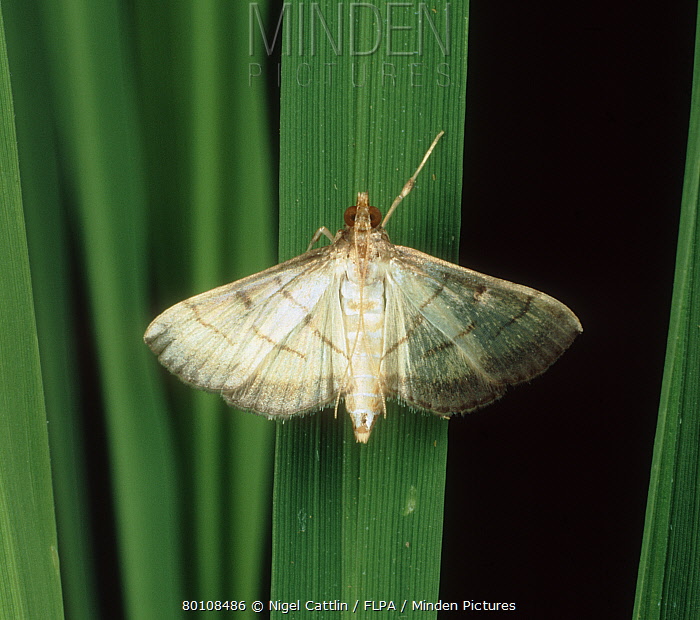
It is greenish caterpillar that feed inside the fold made by fastening together the edges of a leaf. Moths are golden or yellowish brown; the wings have 2-3 wavy lines characterized by dark bands. They lay oval, creamy white egg on the leaves and leaf sheath.
Damage: young larva feed on tender leaves without folding them. The older larvae fasten the longitudinal margins of leaf together with a sticky substance and feed inside the fold by scrapping the green matter. The scrapped leaf become membranous, turn white and finally wither. The heavily infested crop has streaks and appear whitish from a distance. Single larva damages a number of leaves as it migrates from leaf to another as a result of attack photosynthetic activity of leaves is interfered and the plants are exposed to fungal and bacterial infections.
Management
- Use light traps to reduce the population
- Maintain wider spacing and use low nitrogenous fertilizer
- Use Trichogramma chilonis for 6 times @50000-100000 per hectare soon after the appearance of moth.
- Spray cartap 50 WP @ 600 g ha-1 or monocrotophos 36 WSC @ 850 ml ha-1or chlorpyriphos 20 EC @ 1500 ml ha-1or quinalphos 25 EC @ 2000 ml ha-1.
- Spraying should be done only when there are 3 freshly damaged leaves per hill
6. Rice ear cutting caterpillar - Mythimna separata
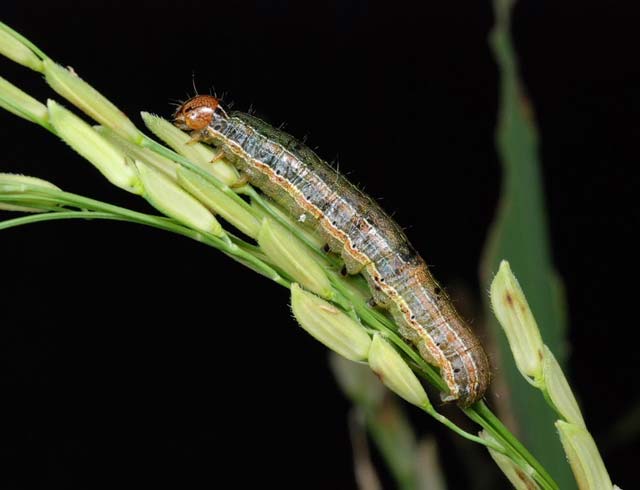
This is also known as armyworm of which the adult is pale brown. They lay egg in overlapping rows. The larva larva pupates in clumps of paddy, in cracks and crevices in ground or in loose soil.
Damage: caterpillar cause damage to paddy leaves and ears. Newly hatched larva feeds on the epidermis of the tender leaves. The second and third instar larva feed by cutting the leaves from the edge toward mid rib. The fourth, fifth and sixth instar larvae besides damaging leaves also cut off the panicles mostly at the base.
Management
- Collect and destroy the caterpillar
- Install light traps
- 1 ml of methyl parathion 50EC or 0.5ml fenitrothion 100EC or 0.9ml diazinon 60EC or 1.3ml monocrotophos 36SL or 2ml chloropyriphos 20 EC or 1.5ml fenthoate 50EC or 2ml phasalone 35EC or 2ml endosalfon 35EC or 2ml quinolphos 25EC during evening hours.
1. Pink borer - Sesamia inferens
The larvae are pinkish, smooth cylindrical body about 25mm.The moth is straw colored with stout body. These are nocturnal and lay eggs on leaves or on the ground. Damage in wheat are dead heart in young plants and are killed together, older plants are killed leaving few grains only.
MANAGEMENT:
- Removal of plants showing early damage symptoms: removal and destruction of infested plants from the base
- Use of Bacillus thuringiensis @3gm/lit.
- Use of biopesticides: Release of Trichogramma chilonis at rate of around 5o thousand to 1 lakh per hectare.
- Use of safe chemical pesticides/ Seed and At-Planting Insecticide Treatments:
- To fields showing greater than 5 % dead heart symptoms, spray with 875 ml Triazophos 40 EC or 1.25-2.5 liters of chloropyriphos 20EC in 500-1000 liter of water.
2. Army worm - Mythimna separate 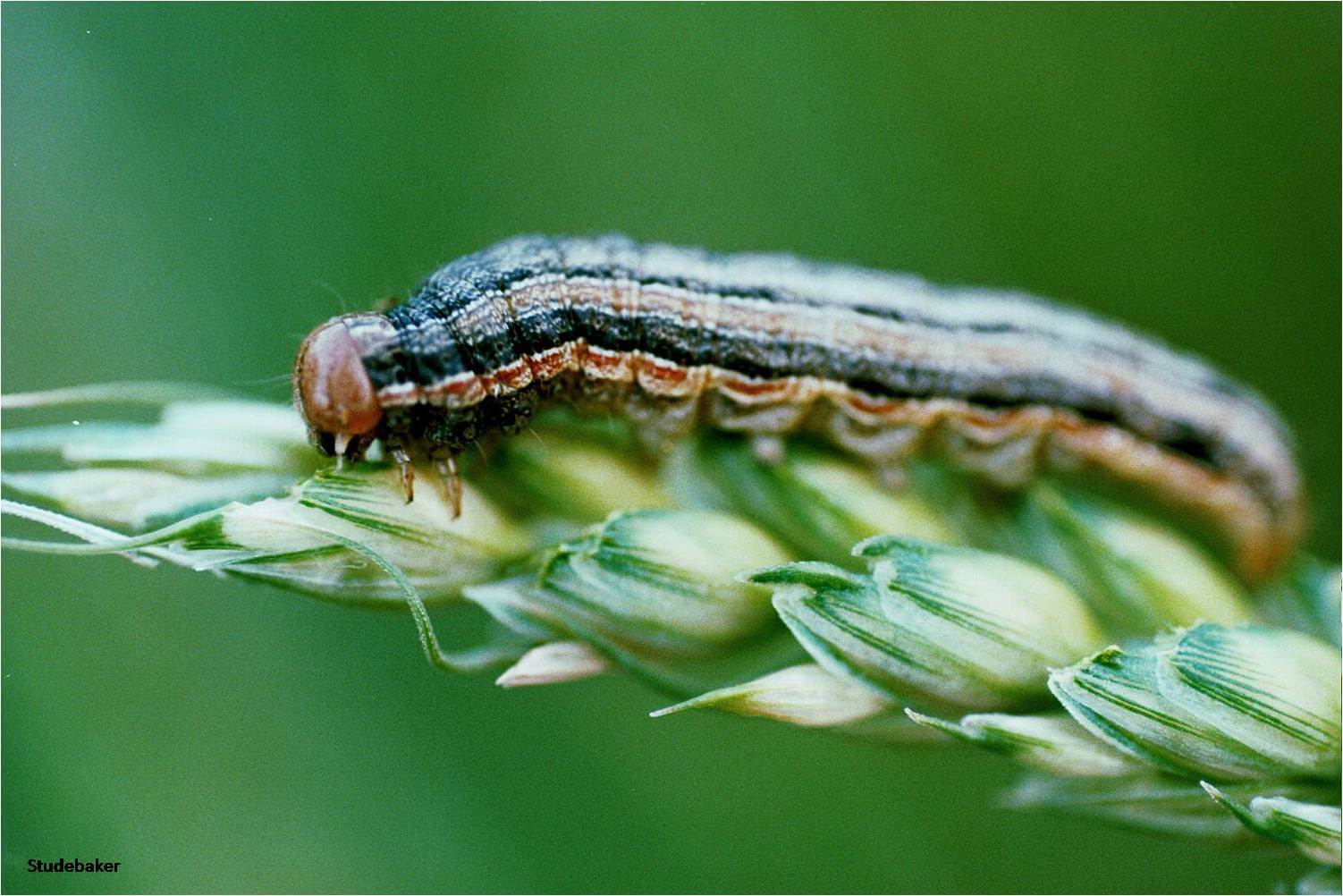
Armyworms are occasionally a problem in corn, especially in weedy fields, in fields near severely infested small grain, and in no-tillage corn. The adults are pale brown while larvae are voracious, dull-white, green. It causes naked(skeletonized), cut crops. Maximum infestation occurs at rise of spring and also damages inflorescence, ear, grains.
MANAGEMENT:
- Manual operations: handpicking of large caterpillars, beetles and egg masses and use of sweep nets, wire gauges etc.
- Use of safe chemical pesticides/ Seed and At-Planting Insecticide Treatments:
- form pit around field and sprinkle Malathion 5% ; Chloropyriphos 1.5%
- spray 500 ml dichlorovous 85SL @3 kg of carbaryl 50 WP or 1 lit of Quinalphos 25 EC in 500 lit water per ha.
3. Wireworms - Agriotes Spp. 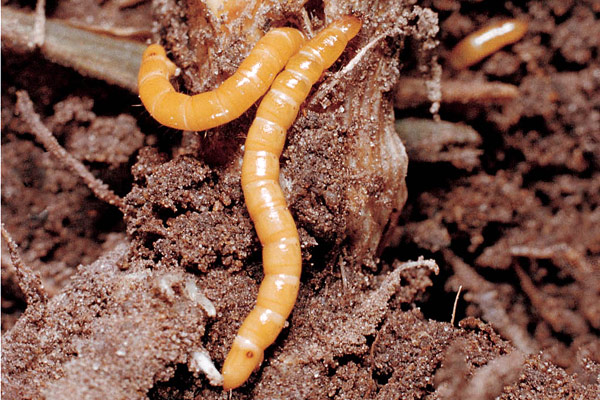
Wireworms look wiry with conspicuous segments. The adult click beetles have two characteristic rear-facing pointed corners of pronotum. The pests reduce germination rate by feeding on germinating seed , damaging or eliminating a potential plant. Wireworms may also injure corn by feeding on soft stem and root tissues underground.
MANAGEMENT:
- Crop rotation including alfa-alfa and high glucosinolate or use of Brassica spp.
- Use of trap crops: trap crops used for maize could include wheat.
- Use of biopesticides: Release of Trichogramma chilonis at rate of around 1 lakh per hectare and use of fungi like Metarrhizium, Beauveria.
- Destruction of pest harbouring places.
4. Termites - Odonotermes obesus/Microtermes obesi 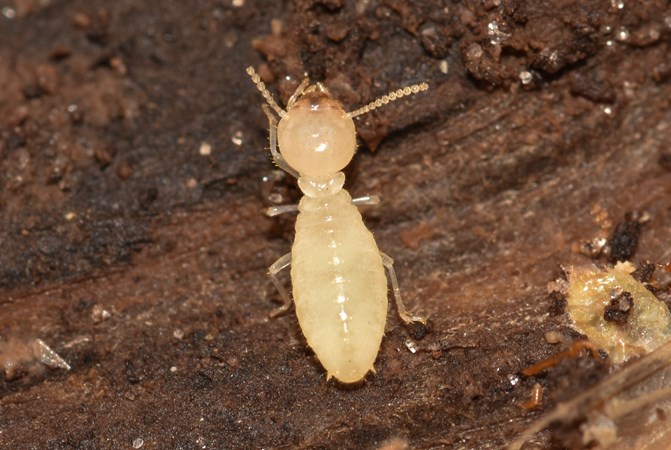
These are important pests in wheat. These are delicate white bodies with light brown head around 3-6 mm long. They cause destruction of germinating grains. Hollow main primary root beneath the soil filled with soil, tunnels found along the shoot filled with soil is seen.
MANAGEMENT:
- Destruction of pest harbouring places: destroy the stubbles, weed and possible alternate hosts of pests like stem borer through different cultural practices
- Locating termitarium for removal
- Use of safe chemical pesticides/ Seed and At-Planting Insecticide Treatments:
- Seed treatment with Chloropyriphos @6ml/kg of seed.
- Soil application of Chloropyriphos 50 EC @10ml/l as a soil drench at sowing time in termite prone soil.
- Use Chloropyriphos 10 G @ 1 kg per ropani before sowing in heavily infected area
- Us of kerosene as an alternative.
1. Maize Stem/Shoot Borer - Chilo Partellus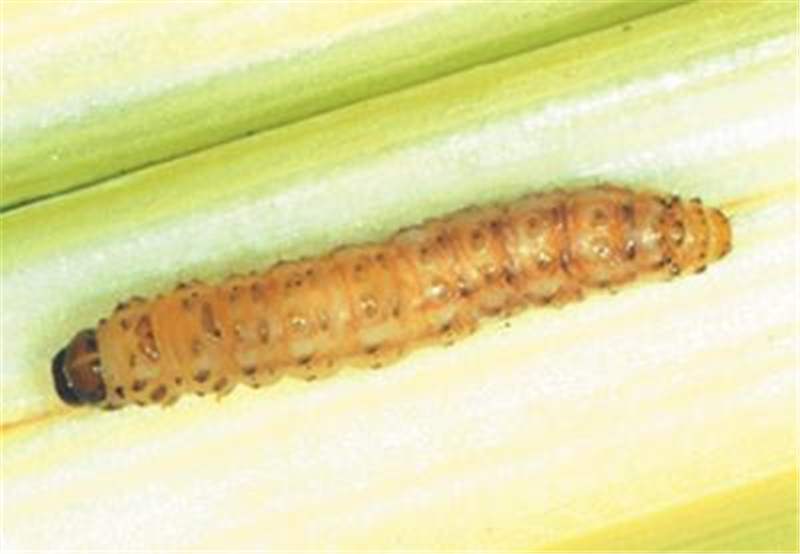
Chilo partellus is a key pest throughout Nepal . These insects are yellowish brown with straw coloured wings with marks, hairy hindwings. The larvae are yellowish brown with a brown head.
In maize, larvae bore holes visible on the stem near the nodes. They cause causing typical “shot hole” symptom. In severe cases, dead hearts are formed and such plants do not bear the ears.
MANAGEMENT:
- Release of Trichogramma chilonis at rate of around 1 lakh per hectare
- Inter-cropping with legume reduces borer
- Clip the lower leaves of maize upto the 4th
- Use of safe chemical pesticides/ Seed and At-Planting Insecticide Treatments:
- use carbofuran 3G at or before sowing @33 kg per hectare
- Fenvalerate 20EC @375ml/ha, Cypermethrin 10EC @650ml/ha in250-500 litres of water as foliar spray
- 15 kg granular pesticide of fipronil
2. Corn Leaf Aphid - Rhopalosiphum maydis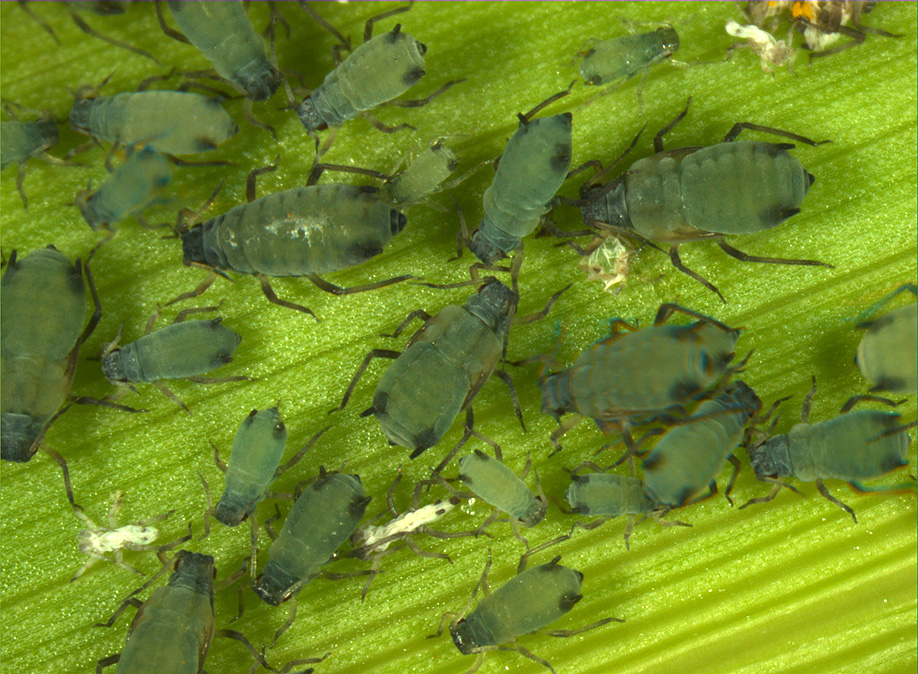
Maize, also reported to occur on sorghum, wheat, and barley. Yellow, green in color with nymphs are wingless adults with smaller size. Corn leaf aphid acts as a vector of Maize dwarf mosaic virus (MDMV). It causes leaf mottling and discoloration; reddening of corn leaves exacerbated under drought stress. The aphid also produce a sticky honeydew.
MANAGEMENT:
- Use Aphilines wasp as parasitoid
- Avoid buying infested seedlings for the nursery
- Use of mineral oil @15ml/l
- Treatment of roots with Malathion, tobacco
- use carbofuran 3G at or before sowing @15gm per plant
3. Army worm - Mythimna separate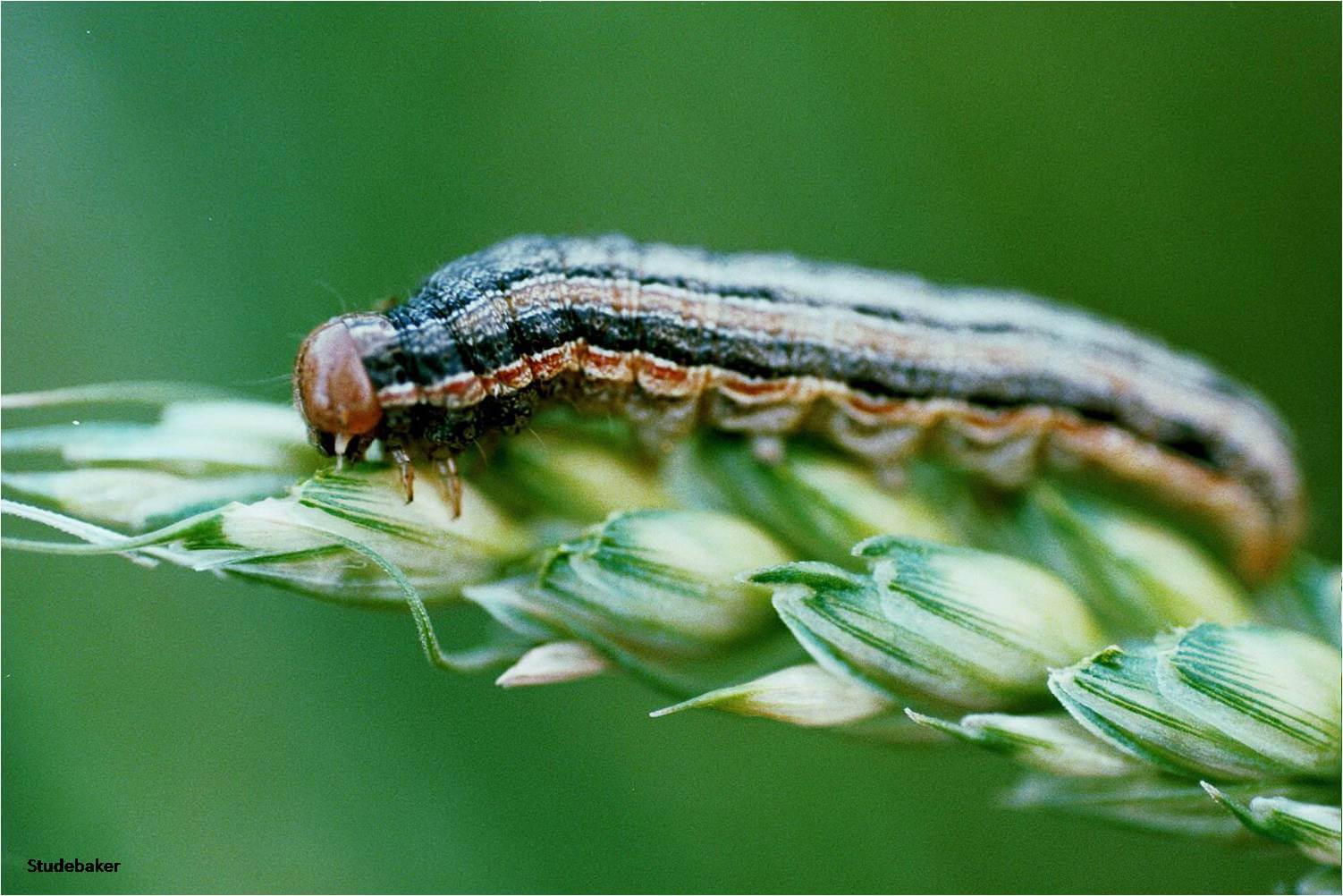
Armyworms are occasionally a problem in corn, especially in weedy fields, in fields near severely infested small grain, and in no-tillage corn. The adults are pale brown while larvae are voracious, dull-white, green. It causes naked(skeletonized), cut crops. Maximum infestation occurs at rise of springand also damages inflorescence, ear, grains.
MANAGEMENT:
- Removal and destruction of weeds
- Manual operations: handpicking of large caterpillars, beetles and egg masses and use of sweep nets, wire gauges etc.
- flooding irrigation
- Use of safe chemical pesticides/ Seed and At-Planting Insecticide Treatments:
- form pit around field and sprinkle Malathion 5% ; Chloropyriphos 1.5%
- spray 500 ml dichlorovous 85SL o3 kg of carbaryl 50 WP or 1 lit of Quinalphos 25 EC in 500 lit water per ha.
4. Maize Stem Fly - Atherigona orientalis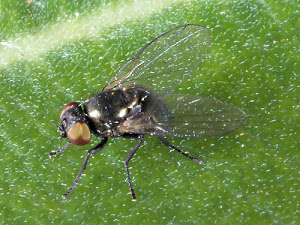
These are small grey coloured fly. The larvae are small, pale yellow tappering towards head. It affects the maize plants at the seedling stage and leads to drying of the seedlings or ‘dead heart’.
MANAGEMENT:
- Seed treatment with imidacloprid 70 WS 10 g/kg of seeds
- Use of safe chemical pesticides/ Seed and At-Planting Insecticide Treatments:
- Carbofuran 3%CG 33.3 kg/ha
- Dimethoate 30%EC 1155 ml/ha
- Phorate 10%CG 10 kg/ha
5. Wireworms- Agriotes Spp. 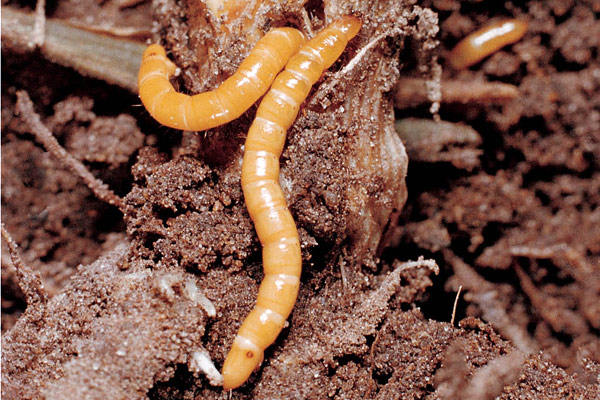
Wireworms look wiry with conspicuous segments. The adult click beetles have two characteristic rear-facing pointed corners of pronotum. The pests reduce germination rate by feeding on germinating seed , damaging or eliminating a potential plant. Wireworms may also injure corn by feeding on soft stem and root tissues underground.
MANAGEMENT:
- Crop rotation including alfa-alfa and high glucosinolate or use of Brassica spp.
- Use of trap crops: trap crops used for maize could include wheat.
- Use of biopesticides: Release of Trichogramma chilonis at rate of around 1 lakh per hectare and use of fungi like Metarrhizium, Beauveria.
- Destruction of pest harbouring places.
1. Pod Borer (Helicoverpa armigera hunber )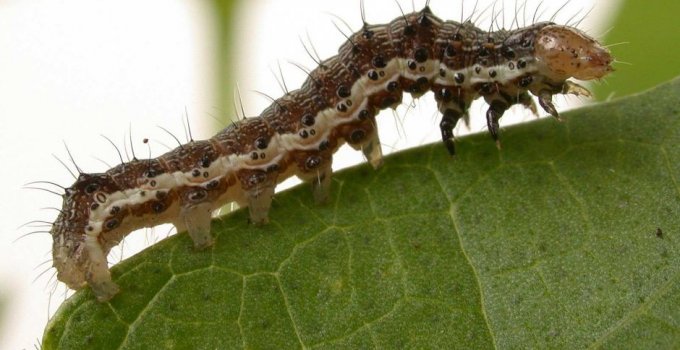
They are the polyphagous pest. The adult moth is of 20 mm long and has brown color. They are active at night
Damage: The larva feed short time on tender leaves by scrapping green tissues and shift to flower buds and tender shoots.
Management: Helicoverpa spp. has many parasites & predators that give adequate control of this pest. In some areas use of pesticide results to increase in population through the reduction of these natural enemies.
Spray with monocrotophous 36% SL , chloropyriphos 20% EC, synthetic pyrethroids and deltamethrin 11% W/W EC ( Decis 380 g/L a.i/ha) and other at the time of flowering and early pod setting
2. Cowpea aphid (Aphis craccivora Koch ) 
Aphids are serious pest in all lentil growing areas. The adult aphids are dark colored aphids but the appendages are whitish with black tips.They are shiny black sometime with fine dusting of white powder.
Damage: Aphids feed on plant sap, disrupting the normal plant growth pattern including reduction in root and nodulation growth. At high Aphid densities, plants are deformed;stunted and seed set is reduced. A cowpea aphid does not produce toxins or other persistent effects once aphids are removed. Normal plant growth rates are resumed.
Management: Spray with Neem Oil 3000 ppm @ 2ml/l else spray with systemic or contact insecticides to protect susceptible crops. Systemic materials are often applied at planting including Dimethoae 30% EC (400 g a.i/l) at the rate of 0.8 l/ha.
3. Armyworm ( Spodoptera exigua hubner )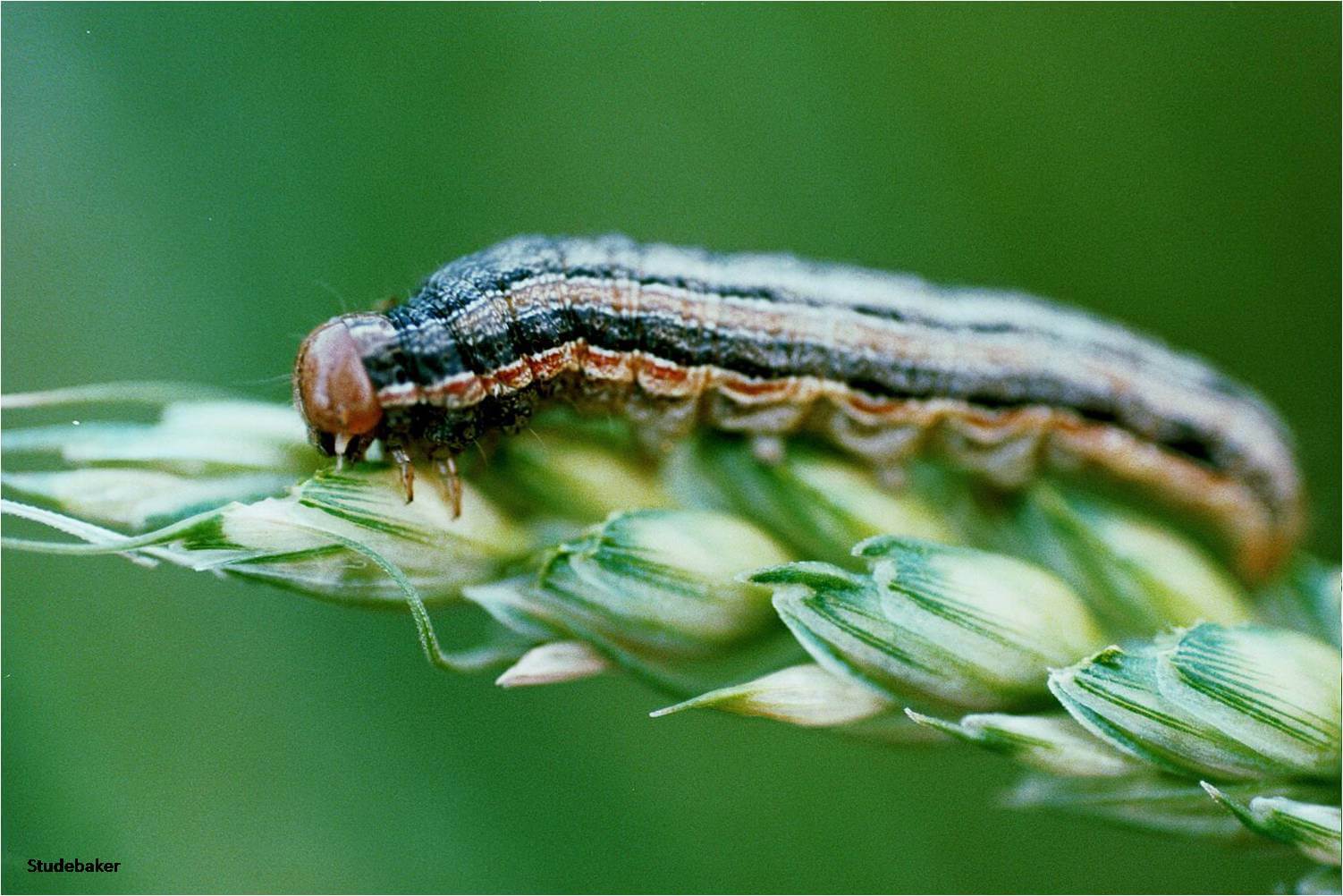
Armyworm (S. exigua) is a polyphagous pest. The adult moth body colour greyish brown, forewings and hind wings are semitransparent with a dark margin.
Damage: The larvae feed on the foliage and only severe infestation can defoliate the plants. The army worm rarely causes economic damage in lentil.
Management: Collect and destroy the caterpillar.Spray 500 ml of Dichlorovous 85 SL or 3 kg of carbaryl 50 WP or 1 liter of Quinalphos 25 EC in 500 liters of water per ha.
4. Cutworm ( Agrotis ipsilon hubnagel ) 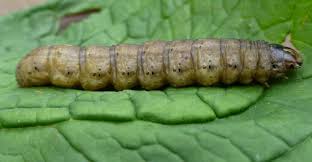
A.ipsilon is a cosmopolitan and a polyphagous pest. The adult moths are grey brown color, large in size with a wingspan of 40 mm. The forewings are light brown color and hind wings are creamy white with brown edges.
Damage: The larvae of cutworm cuts the blant during night and plant are seen fallen during day, sometimes they also carry the fallen plant to the holes where they hide during the day. Some species of A.ipsilon feed on the upper leaves before moving to the soil surface.
Management: Destroying the holes where they harbour. Deep ploughing of the field in between the crops.
Collect and destroy caterpillar mechanically.
Broadcast Bt mixed bait ( 2 gm Bacillus thuringiensis formulation with 1 kg of wheat bran) @ 10 kg of per ha.
5. Bud Weevil ( Apion arrogans wenck )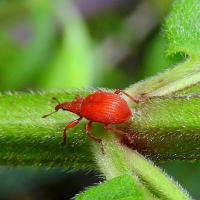
The bud weevil (A. arrogans) body length is 3 mm and the snout is longer than the body. They are long legs. Colors of adult weevil have dark blue elytra with black head, thorax, legs and abdomen.The species larvae colors are yellow and legless.
Damage: Adult weevils feed on lentil leaves making small holes but the larvae feed mostly bucks and flowers and the ovary is destroyed he larva cab be found inside the buds and which feeds on the developing seeds. The budweevil A.arrogans also transmit broad bean mottle virus (BBMV) in lentil.
Management: The serious infestation is not observed due to bud weevil. The crop rotation, destruction of damaged buds and use of natural enemies are the economic ways to control the weevil. If the population of weevils are high and infestation is more then the monocrotophos 36 SL @ 2 ml/ha is used to control the weevils.
Copyright 2019. All rights reserved